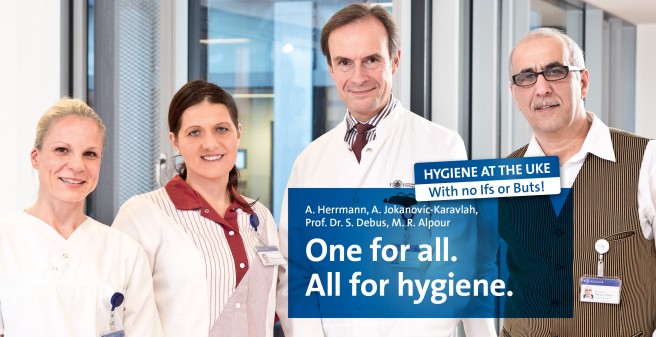Hospital Hygiene at the UKE
Hospital hygiene deals with the recognition and control, but primarily with the prevention of hospital infections. In Germany, about 900,000 patients contract an illness due to a hospital infection every year. This high rate needs to be reduced through resolute action. We are committed to that! Our goal is not to achieve a germ-free hospital, but to prevent the development and transmission of infections. For this purpose, we develop prevention and therapy strategies and apply them in a consistent manner. Protecting patients from infections can only succeed if all occupational groups involved in patient care are committed to hygiene. Hygiene is teamwork. Therefore, the Hospital Hygiene Department cannot ensure hygiene at the UKE all by itself. Hygiene is everyone’s concern: “One for all. All for hygiene.” That is the motto of our hygiene campaign at the UKE.
Everyone makes an important contribution to the safety of our patients. As members of the Hospital Hygiene Department, we want to make a significant contribution. Please feel free to talk to us.
Hand Disinfection
We care a great deal about the safety of our patients. In order to prevent the transmission of infections in the hospital, the observance of hygiene measures plays a significant role. The disinfection of hands is the most important measure in this effort.
We would like to ask you to observe the hygiene measures for the protection of your loved ones and other patients. Before any visits with children, please coordinate the visit with the ward personnel. Below, we have assembled the most important information for performing hand disinfection:
Where?
- Please always disinfect your hands directly in front of, or in the patient’s room.
When?
- When entering and leaving the room
- Also, after blowing your nose, sneezing, or coughing
- If you should suffer from a cold, please ask for a mouth/nose mask, and put it on.
How?
- Squeeze two to three squirts of hand disinfectant from the dispenser.
- Please rub the disinfectant evenly and thoroughly over all areas of your hands (including the wrists) until the liquid has dried.
Protective Clothing
When a patient needs to be isolated, in order to prevent the spread of a pathogen, additional measures are required. These protective measures depend on the pathogen and its transmission paths. This means, for example, that the patient is accommodated in an individual room and that – in case of possible contact – appropriate protective clothing (white coat, protective gloves, mouth/nose mask, if necessary) is worn. Therefore, we would like to ask you to observe the following instructions for your own protection as well as that of your loved ones.
Prior to entering the patient’s room:
- Please announce your visit to the staff.
- Please take as few personal belongings as possible into the room. Due to hygienic reasons, it is not allowed to place personal belongings on the storage shelves, floors, or windowsills of the room. Please ask the staff about storage options.
- Then, please allow the staff to show you how to put on and take off the protective clothing as well as how to disinfect your hands.
- Always disinfect your hands prior to putting on the protective clothing.
- Make sure that the white coat is closed at the back.
Prior to leaving the patient’s room:
- Take off the protective clothing inside the room and place it in the provided disposal container.
- Immediately afterwards, please disinfect your hands again and leave the room.
Questions and Contact
If you have any questions related to hand hygiene, protective clothing, or other hygienic procedures, please inquire with the nursing personnel in the ward. If requested, we will be happy to provide you with an individual hygiene consultation.


